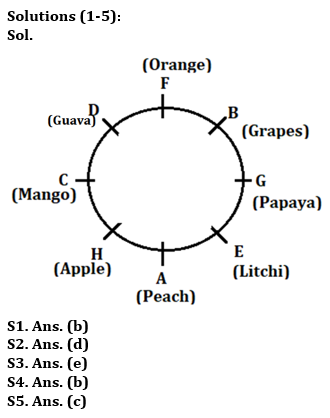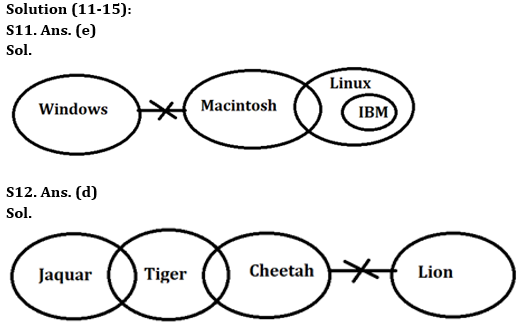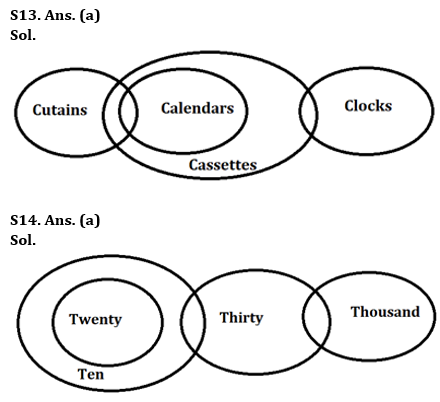Directions (1-5): Study the information carefully and answer the questions given below.
Eight persons A, B, C, D, E, F, G and H are sitting in a circular table and all of them facing towards center. They all like different fruits i.e., Grapes, papaya, Orange, Mango, Apple, Litchi, Guava and Peach but not necessary in same order.
A likes peach and sits second to the right of C. Two persons sit between C and E who likes Litchi. B who likes Grapes sit opposite to H. B is not immediate neighbor of the one who likes peach. The one who likes Mango sits opposite to the one who likes Papaya. F sits second to the right of the one who likes papaya. D is immediate neighbor of the one who likes Orange. H does not like Guava. G is not immediate neighbor of A.
Q1. Which of the following fruit D likes?
(a) Apple
(b) Guava
(c) Orange
(d) Papaya
(e) None of these
Q2. Who among the following sits immediate left of F?
(a) D
(b) C
(c) G
(d) B
(e) None of these
Q3. Four of the following five are alike in certain way based from a group, find the one who does not belong to that group?
(a) C-G
(b) F-A
(c) B-H
(d) E-D
(e) D-H
Q4. Which of the following combination is true?
(a) B- Apple
(b) H-Apple
(c) D-Orange
(d) A-Litchi
(e) C-Papaya
Q5. Which among the following fruit G likes?
(a) Grapes
(b) Orange
(c) Papaya
(d) Mango
(e) None of these
Direction (6-10): Study the following data carefully and answer the questions accordingly.
Eight boxes i.e. A, B, C, D, E, F, G, and H are kept one above the other in a stack. The lowermost stack is numbered 1, the stack above it is numbered 2, and so on until the topmost stack is numbered 8. All the information is not necessarily in the same order. Three boxes are placed between Box A and Box H. Box B is places two places below Box A. Four Boxes are placed between Box B and Box G. Box D is placed in an even-numbered position below Box B. One box is placed between Box C and Box E. Box C is placed below Box H.
Q6. How many boxes are placed above Box F?
(a) Three
(b) One
(c) None
(d) More than three
(e) Two
Q7. How many boxes are placed between Box B and Box H?
(a) One
(b) Four
(c) Three
(d) None
(e) Two
Q8. How many boxes are placed below Box G?
(a) One
(b) Three
(c) None
(d) Two
(e) Four
Q9. Number of boxes placed above Box E is same as number of boxes placed below Box __.
(a) C
(b) D
(c) B
(d) H
(e) None of these
Q10. Which amongst the following box is placed in 3rd position from the bottom?
(a) H
(b) C
(c) E
(d) G
(e) None of these
Directions (11-15): In the question below, three statements are given followed by the conclusions. You have to take the given statements to be true even if they seem to be at variance with commonly known facts. Read all the conclusions and then decide which of the given conclusions logically follows from the given statements disregarding commonly known facts.
Q11. Statements: No Window is Macintosh.
A few Macintosh are Linux.
Only Linux are IBM
Conclusion: I. Some Macintosh is definitely IBM
II. Some IBM can be Windows
(a) Only conclusion I follows
(b) Only conclusion II follows
(c) Either conclusion I or II follows
(d) Both conclusions I and II follow
(e) Neither conclusion I nor II follows
Q12. Statements: No Cheetah is Lion.
Only a few Cheetah are Tiger.
Mostly tiger are Jaquar.
Conclusions: I. All Cheetah can be Jaquar
II. Some Lion can be Jaquar
(a) Only conclusion I follows
(b) Only conclusion II follows
(c) Either conclusion I or II follows
(d) Both conclusions I and II follow
(e) Neither conclusion I nor II follows
Q13. Statements: Some curtains are calendar.
All calendars are cassettes.
Some cassettes are clocks.
Conclusions: I. Some cassettes are curtains
II. All curtains are cassettes
(a) Only conclusion I follows
(b) Only conclusion II follows
(c) Either conclusion I or II follows
(d) Both conclusions I and II follow
(e) Neither conclusion I nor II follows
Q14. Statements: Only ten are twenty.
Mostly ten are thirty.
Some thirty are thousand
Conclusions: I. No twenty is thousand
II. Some thirty being twenty is a possibility
(a) Only conclusion I follows
(b) Only conclusion II follows
(c) Either conclusion I or II follows
(d) Both conclusions I and II follow
(e) Neither conclusion I nor II follows
Q15. Statements: Only a few pink are yellow.
No yellow is green.
Mostly green are brown
Conclusions: I. Some pink are not brown
II. All pink being yellow is a possibility
(a) Only conclusion I follows
(b) Only conclusion II follows
(c) Either conclusion I or II follows
(d) Both conclusions I and II follow
(e) Neither conclusion I nor II follows
Solutions










 GA Capsule for SBI Clerk Mains 2025, Dow...
GA Capsule for SBI Clerk Mains 2025, Dow...
 The Hindu Review October 2022: Download ...
The Hindu Review October 2022: Download ...
 Without These Documents, Your Bank Exam ...
Without These Documents, Your Bank Exam ...





